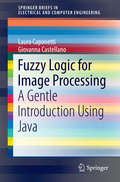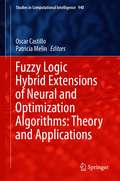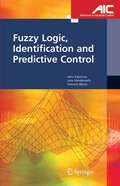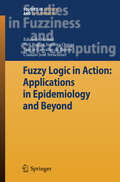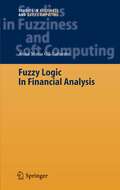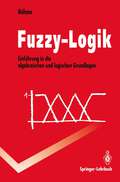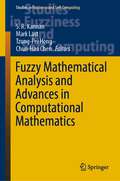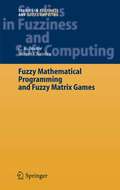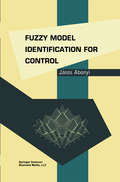- Table View
- List View
Fuzzy Logic for Image Processing: A Gentle Introduction Using Java (SpringerBriefs in Electrical and Computer Engineering)
by Laura Caponetti Giovanna CastellanoThis book provides an introduction to fuzzy logic approaches useful in image processing. The authors start by introducing image processing tasks of low and medium level such as thresholding, enhancement, edge detection, morphological filters, and segmentation and shows how fuzzy logic approaches apply. The book is divided into two parts. The first includes vagueness and ambiguity in digital images, fuzzy image processing, fuzzy rule based systems, and fuzzy clustering. The second part includes applications to image processing, image thresholding, color contrast enhancement, edge detection, morphological analysis, and image segmentation. Throughout, they describe image processing algorithms based on fuzzy logic under methodological aspects in addition to applicative aspects. Implementations in java are provided for the various applications.
Fuzzy Logic Hybrid Extensions of Neural and Optimization Algorithms: Theory and Applications (Studies in Computational Intelligence #940)
by Oscar Castillo Patricia MelinWe describe in this book, recent developments on fuzzy logic, neural networks and optimization algorithms, as well as their hybrid combinations, and their application in areas such as, intelligent control and robotics, pattern recognition, medical diagnosis, time series prediction and optimization of complex problems. The book contains a collection of papers focused on hybrid intelligent systems based on soft computing. There are some papers with the main theme of type-1 and type-2 fuzzy logic, which basically consists of papers that propose new concepts and algorithms based on type-1 and type-2 fuzzy logic and their applications. There also some papers that presents theory and practice of meta-heuristics in different areas of application. Another group of papers describe diverse applications of fuzzy logic, neural networks and hybrid intelligent systems in medical applications. There are also some papers that present theory and practice of neural networks in different areas of application. In addition, there are papers that present theory and practice of optimization and evolutionary algorithms in different areas of application. Finally, there are some papers describing applications of fuzzy logic, neural networks and meta-heuristics in pattern recognition problems.
Fuzzy Logic, Identification and Predictive Control (Advances in Industrial Control)
by Jairo Jose Espinosa Oviedo Joos P.L. Vandewalle Vincent WertzModern industrial processes and systems require adaptable advanced control protocols able to deal with circumstances demanding "judgement” rather than simple "yes/no”, "on/off” responses: circumstances where a linguistic description is often more relevant than a cut-and-dried numerical one. The ability of fuzzy systems to handle numeric and linguistic information within a single framework renders them efficacious for this purpose. Fuzzy Logic, Identification and Predictive Control first shows you how to construct static and dynamic fuzzy models using the numerical data from a variety of real industrial systems and simulations. The second part exploits such models to design control systems employing techniques like data mining. This monograph presents a combination of fuzzy control theory and industrial serviceability that will make a telling contribution to your research whether in the academic or industrial sphere and also serves as a fine roundup of the fuzzy control area for the graduate student.
Fuzzy Logic in Action: Applications in Epidemiology and Beyond (Studies in Fuzziness and Soft Computing #232)
by Eduardo Massad Neli Regina Ortega Laecio Carvalho de Barros Claudio J. StruchinerFuzzy Logic in Action: Applications in Epidemiology and Beyond, co-authored by Eduardo Massad, Neli Ortega, Laécio Barros, and Cláudio Struchiner is a remarkable achievement. The book brings a major paradigm shift to medical sciences exploring the use of fuzzy sets in epidemiology and medical diagnosis arena. The volume addresses the most significant topics in the broad areas of epidemiology, mathematical modeling and uncertainty, embodying them within the framework of fuzzy set and dynamic systems theory. Written by leading contributors to the area of epidemiology, medical informatics and mathematics, the book combines a very lucid and authoritative exposition of the fundamentals of fuzzy sets with an insightful use of the fundamentals in the area of epidemiology and diagnosis. The content is clearly illustrated by numerous illustrative examples and several real world applications. Based on their profound knowledge of epidemiology and mathematical modeling, and on their keen understanding of the role played by uncertainty and fuzzy sets, the authors provide insights into the connections between biological phenomena and dynamic systems as a mean to predict, diagnose, and prescribe actions. An example is the use of Bellman-Zadeh fuzzy decision making approach to develop a vaccination strategy to manage measles epidemics in São Paulo. The book offers a comprehensive, systematic, fully updated and self- contained treatise of fuzzy sets in epidemiology and diagnosis. Its content covers material of vital interest to students, researchers and practitioners and is suitable both as a textbook and as a reference. The authors present new results of their own in most of the chapters. In doing so, they reflect the trend to view fuzzy sets, probability theory and statistics as an association of complementary and synergetic modeling methodologies.
Fuzzy Logic in Financial Analysis (Studies in Fuzziness and Soft Computing #175)
by Anna Maria Gil-LafuenteIn today’s increasingly complex and uncertain business environment, financial analysis is yet more critical to business managers who tackle problems of an economic or business nature. Knowledge based on formal logic and even experience becomes less sufficient. This volume systematically sets out the basic elements on which to base financial analysis for business in the new century. It incorporates a previous work that can serve as the basis and foundation for the new contributions that are now being made in the field of financial economy and intend to provide business with instruments and models suitable for dealing with the new economic context. In dealing with rapid and unpredictable changes in technological and business conditions, it postulates a growing reliance on the opinions of experts instead of past data or probabilistic forecasts, which is a radical change but may yield fruitful results. For this reason, much emphasis is devoted to the problem of aggregation of the opinion of experts in the financial field, with the object of limiting, wherever possible, the subjective component of the opinions and making sure that the decisions have the best guarantee of reaching the desired objectives.
Fuzzy Logic in Its 50th Year: New Developments, Directions and Challenges (Studies in Fuzziness and Soft Computing #341)
by Cengiz Kahraman Uzay Kaymak Adnan YaziciThis book offers a multifaceted perspective on fuzzy set theory, discussing its developments over the last 50 years. It reports on all types of fuzzy sets, from ordinary to hesitant fuzzy sets, with each one explained by its own developers, authoritative scientists well known for their previous works. Highlighting recent theorems and proofs, the book also explores how fuzzy set theory has come to be extensively used in almost all branches of science, including the health sciences, decision science, earth science and the social sciences alike. It presents a wealth of real-world sample applications, from routing problem to robotics, and from agriculture to engineering. By offering a comprehensive, timely and detailed portrait of the field, the book represents an excellent reference guide for researchers, lecturers and postgraduate students pursuing research on new fuzzy set extensions.
Fuzzy Logic Techniques for Autonomous Vehicle Navigation (Studies in Fuzziness and Soft Computing #61)
by Dimiter DriankovIn the past decade a critical mass of work that uses fuzzy logic for autonomous vehicle navigation has been reported. Unfortunately, reports of this work are scattered among conference, workshop, and journal publications that belong to different research communities (fuzzy logic, robotics, artificial intelligence, intelligent control) and it is therefore not easily accessible either to the new comer or to the specialist. As a result, researchers in this area may end up reinventing things while being unaware of important existing work. We believe that research and applications based on fuzzy logic in the field of autonomous vehicle navigation have now reached a sufficient level of maturity, and that it should be suitably reported to the largest possible group of interested practitioners, researches, and students. On these grounds, we have endeavored to collect some of the most representative pieces of work in one volume to be used as a reference. Our aim was to provide a volume which is more than "yet another random collection of papers," and gives the reader some added value with respect to the individual papers. In order to achieve this goal we have aimed at: • Selecting contributions which are representative of a wide range of prob lems and solutions and which have been validated on real robots; and • Setting the individual contributions in a clear framework, that identifies the main problems of autonomous robotics for which solutions based on fuzzy logic have been proposed.
Fuzzy Logic Type 1 and Type 2 Based on LabVIEW™ FPGA (Studies in Fuzziness and Soft Computing #334)
by Pedro Ponce-Cruz Arturo Molina Brian MacCleeryThis book is a comprehensive introduction to LabVIEW FPGA™, a package allowing the programming of intelligent digital controllers in field programmable gate arrays (FPGAs) using graphical code. It shows how both potential difficulties with understanding and programming in VHDL and the consequent difficulty and slowness of implementation can be sidestepped. The text includes a clear theoretical explanation of fuzzy logic (type 1 and type 2) with case studies that implement the theory and systematically demonstrate the implementation process. It goes on to describe basic and advanced levels of programming LabVIEW FPGA and show how implementation of fuzzy-logic control in FPGAs improves system responses. A complete toolkit for implementing fuzzy controllers in LabVIEW FPGA has been developed with the book so that readers can generate new fuzzy controllers and deploy them immediately. Problems and their solutions allow readers to practice the techniques and to absorb the theoretical ideas as they arise. Fuzzy Logic Type 1 and Type 2 Based on LabVIEW FPGA™, helps students studying embedded control systems to design and program those controllers more efficiently and to understand the benefits of using fuzzy logic in doing so. Researchers working with FPGAs find the text useful as an introduction to LabVIEW and as a tool helping them design embedded systems.
Fuzzy Logic with Engineering Applications
by Timothy J. RossThe latest update on this popular textbook The importance of concepts and methods based on fuzzy logic and fuzzy set theory has been rapidly growing since the early 1990s and all the indications are that this trend will continue in the foreseeable future. Fuzzy Logic with Engineering Applications, Fourth Edition is a new edition of the popular textbook with 15% of new and updated material. Updates have been made to most of the chapters and each chapter now includes new end-of-chapter problems. Key features: New edition of the popular textbook with 15% of new and updated material. Includes new examples and end-of-chapter problems. Has been made more concise with the removal of out of date material. Covers applications of fuzzy logic to engineering and science. Accompanied by a website hosting a solutions manual and software. The book is essential reading for graduates and senior undergraduate students in civil, chemical, mechanical and electrical engineering as wells as researchers and practitioners working with fuzzy logic in industry.
Fuzzy Logic with Engineering Applications
by Timothy J. RossThe latest update on this popular textbook The importance of concepts and methods based on fuzzy logic and fuzzy set theory has been rapidly growing since the early 1990s and all the indications are that this trend will continue in the foreseeable future. Fuzzy Logic with Engineering Applications, Fourth Edition is a new edition of the popular textbook with 15% of new and updated material. Updates have been made to most of the chapters and each chapter now includes new end-of-chapter problems. Key features: New edition of the popular textbook with 15% of new and updated material. Includes new examples and end-of-chapter problems. Has been made more concise with the removal of out of date material. Covers applications of fuzzy logic to engineering and science. Accompanied by a website hosting a solutions manual and software. The book is essential reading for graduates and senior undergraduate students in civil, chemical, mechanical and electrical engineering as wells as researchers and practitioners working with fuzzy logic in industry.
Fuzzy-Logik: Einführung in die algebraischen und logischen Grundlagen (Springer-Lehrbuch)
by Gert BöhmeDer Begriff "Fuzzy" - 1965 von Lofty A. Zadeh in einer Erweiterung der gewöhnlichen Mengenlehre auf die Verknüpfung unscharfer Mengen kreiert - hat seine Anwendung in zahlreichen Gebieten der Technik gefunden. In diesem Lehrbuch erhält der Leser eine leicht verständliche Einführung in die mathematischen und logischen Grundlagen. Er soll in die Lage versetzt werden, die für die Fuzzy-Logik spezifischen algebraischen und logischen Arbeitsmethoden operativ einzusetzen. Das Lehrbuch wurde mit dem Ziel entwickelt, insbesondere im Selbststudium das Werkzeug "Fuzzy" für die berufspraktische Anwendung zu erarbeiten. Zu diesem Zweck enthält es eine große Anzahl von Beispielen aus der Anwendung sowie Aufgaben mit Lösungen. Fuzzy-Logik wendet sich gleichermaßen an Studenten der Ingenieurwissenschaften, Informatik und Wirtschaftswissenschaften, wie auch an Anwender in der industriellen Praxis, die sich in dieses aktuelle und hochbrisante Gebiet einarbeiten möchten.
Fuzzy-Logik und Fuzzy-Control: Eine anwendungsorientierte Einführung mit Begleitsoftware
by Jörg Kahlert Hubert FrankFuzzy-Logik und Fuzzy-Control: Eine anwendungsorientierte Einführung mit Begleitsoftware
by Jörg Kahlert Hubert FrankDie Fuzzy-Logik (unscharfe Logik) ist in jüngster Zeit vor allem durch japanische Produkte bekannt geworden. Sie eignet sich im Gegensatz zur klassischen Logik hervorragend dazu, verbal formuliertes Wissen und Zusammenhänge auf einem Digitalrechner nachzubilden und für das Ziehen von Schlußfolgerungen oder die Analyse und Steuerung komplexer Vorgänge in sämtlichen Bereichen heranzuziehen. Dabei werden die interessierenden Einflußgrößen als sogenannte "Linguistische Variablen" aufgefaßt und die Zusammenhänge zwischen Ein- und Ausgangsgrößen in Form von WENN ... DANN . .. Regeln formuliert. Ein wesentlicher Anwendungsbereich liegt in der Steuerung und Regelung technischer Systeme (Fuzzy-Control). Die Fuzzy-Technik ermöglicht hier die Automatisierung gerade solcher Prozesse, die bisher mit klassischen Methoden nicht zugänglich waren. Sie bietet dabei eine hervorragende Grundlage, empirisches Prozeßwissen und verbal beschreibbare Steuerungsstrategien unmittelbar umzusetzen.
Fuzzy Machine Learning Algorithms for Remote Sensing Image Classification
by Anil Kumar Priyadarshi Upadhyay A. Senthil KumarThis book covers the state-of-art image classification methods for discrimination of earth objects from remote sensing satellite data with an emphasis on fuzzy machine learning and deep learning algorithms. Both types of algorithms are described in such details that these can be implemented directly for thematic mapping of multiple-class or specific-class landcover from multispectral optical remote sensing data. These algorithms along with multi-date, multi-sensor remote sensing are capable to monitor specific stage (for e.g., phenology of growing crop) of a particular class also included. With these capabilities fuzzy machine learning algorithms have strong applications in areas like crop insurance, forest fire mapping, stubble burning, post disaster damage mapping etc. It also provides details about the temporal indices database using proposed Class Based Sensor Independent (CBSI) approach supported by practical examples. As well, this book addresses other related algorithms based on distance, kernel based as well as spatial information through Markov Random Field (MRF)/Local convolution methods to handle mixed pixels, non-linearity and noisy pixels. Further, this book covers about techniques for quantiative assessment of soft classified fraction outputs from soft classification and supported by in-house developed tool called sub-pixel multi-spectral image classifier (SMIC). It is aimed at graduate, postgraduate, research scholars and working professionals of different branches such as Geoinformation sciences, Geography, Electrical, Electronics and Computer Sciences etc., working in the fields of earth observation and satellite image processing. Learning algorithms discussed in this book may also be useful in other related fields, for example, in medical imaging. Overall, this book aims to: exclusive focus on using large range of fuzzy classification algorithms for remote sensing images; discuss ANN, CNN, RNN, and hybrid learning classifiers application on remote sensing images; describe sub-pixel multi-spectral image classifier tool (SMIC) to support discussed fuzzy and learning algorithms; explain how to assess soft classified outputs as fraction images using fuzzy error matrix (FERM) and its advance versions with FERM tool, Entropy, Correlation Coefficient, Root Mean Square Error and Receiver Operating Characteristic (ROC) methods and; combines explanation of the algorithms with case studies and practical applications.
Fuzzy Machine Learning Algorithms for Remote Sensing Image Classification
by Anil Kumar Priyadarshi Upadhyay A. Senthil KumarThis book covers the state-of-art image classification methods for discrimination of earth objects from remote sensing satellite data with an emphasis on fuzzy machine learning and deep learning algorithms. Both types of algorithms are described in such details that these can be implemented directly for thematic mapping of multiple-class or specific-class landcover from multispectral optical remote sensing data. These algorithms along with multi-date, multi-sensor remote sensing are capable to monitor specific stage (for e.g., phenology of growing crop) of a particular class also included. With these capabilities fuzzy machine learning algorithms have strong applications in areas like crop insurance, forest fire mapping, stubble burning, post disaster damage mapping etc. It also provides details about the temporal indices database using proposed Class Based Sensor Independent (CBSI) approach supported by practical examples. As well, this book addresses other related algorithms based on distance, kernel based as well as spatial information through Markov Random Field (MRF)/Local convolution methods to handle mixed pixels, non-linearity and noisy pixels. Further, this book covers about techniques for quantiative assessment of soft classified fraction outputs from soft classification and supported by in-house developed tool called sub-pixel multi-spectral image classifier (SMIC). It is aimed at graduate, postgraduate, research scholars and working professionals of different branches such as Geoinformation sciences, Geography, Electrical, Electronics and Computer Sciences etc., working in the fields of earth observation and satellite image processing. Learning algorithms discussed in this book may also be useful in other related fields, for example, in medical imaging. Overall, this book aims to: exclusive focus on using large range of fuzzy classification algorithms for remote sensing images; discuss ANN, CNN, RNN, and hybrid learning classifiers application on remote sensing images; describe sub-pixel multi-spectral image classifier tool (SMIC) to support discussed fuzzy and learning algorithms; explain how to assess soft classified outputs as fraction images using fuzzy error matrix (FERM) and its advance versions with FERM tool, Entropy, Correlation Coefficient, Root Mean Square Error and Receiver Operating Characteristic (ROC) methods and; combines explanation of the algorithms with case studies and practical applications.
Fuzzy Mathematical Analysis and Advances in Computational Mathematics (Studies in Fuzziness and Soft Computing #419)
by S. R. Kannan Mark Last Tzung-Pei Hong Chun-Hao ChenThe edited volume includes papers in the fields of fuzzy mathematical analysis and advances in computational mathematics. The fields of fuzzy mathematical analysis and advances in computational mathematics can provide valuable solutions to complex problems. They have been applied in multiple areas such as high dimensional data analysis, medical diagnosis, computer vision, hand-written character recognition, pattern recognition, machine intelligence, weather forecasting, network optimization, VLSI design, etc. The volume covers ongoing research in fuzzy and computational mathematical analysis and brings forward its recent applications to important real-world problems in various fields. The book includes selected high-quality papers from the International Conference on Fuzzy Mathematical Analysis and Advances in Computational Mathematics (FMAACM 2020).
Fuzzy Mathematical Programming and Fuzzy Matrix Games (Studies in Fuzziness and Soft Computing #169)
by C. R. Bector Suresh ChandraGame theory has already proved its tremendous potential for con?ict resolution problems in the ?elds of Decision Theory and Economics. In the recent past, there have been attempts to extend the results of crisp game theory to those con?ict resolution problems which are fuzzy in nature e.g. Nishizaki and Sakawa [61] and references cited there in. These developments have lead to the emergence of a new area in the literature called fuzzy games. Another area in the fuzzy decision theory, which has been growing very fast is the area of fuzzy mathematical programming and its applications to various branches of sciences, Engineering and Management. In the crisp scenario, there exists a beautiful relationship between two person zero sum matrix game theory and duality in linear p- gramming. It is therefore natural to ask if something similar holds in the fuzzy scenario as well. This discussion essentially constitutes the core of our presentation. The objective of this book is to present a systematic and focussed study of the application of fuzzy sets to two very basic areas of decision theory, namely Mathematical Programming and Matrix Game Theory.
Fuzzy Mathematics: An Introduction for Engineers and Scientists (Studies in Fuzziness and Soft Computing #20)
by John N. Mordeson Premchand S. NairIn the mid-1960's I had the pleasure of attending a talk by Lotfi Zadeh at which he presented some of his basic (and at the time, recent) work on fuzzy sets. Lotfi's algebra of fuzzy subsets of a set struck me as very nice; in fact, as a graduate student in the mid-1950's, I had suggested similar ideas about continuous-truth-valued propositional calculus (inffor "and", sup for "or") to my advisor, but he didn't go for it (and in fact, confused it with the foundations of probability theory), so I ended up writing a thesis in a more conventional area of mathematics (differential algebra). I especially enjoyed Lotfi's discussion of fuzzy convexity; I remember talking to him about possible ways of extending this work, but I didn't pursue this at the time. I have elsewhere told the story of how, when I saw C. L. Chang's 1968 paper on fuzzy topological spaces, I was impelled to try my hand at fuzzi fying algebra. This led to my 1971 paper "Fuzzy groups", which became the starting point of an entire literature on fuzzy algebraic structures. In 1974 King-Sun Fu invited me to speak at a U. S. -Japan seminar on Fuzzy Sets and their Applications, which was to be held that summer in Berkeley.
Fuzzy Mathematics: Approximation Theory (Studies in Fuzziness and Soft Computing #251)
by George A. AnastassiouThis monograph is the r st in Fuzzy Approximation Theory. It contains mostly the author s research work on fuzziness of the last ten years and relies a lot on [10]-[32] and it is a natural outgrowth of them. It belongs to the broader area of Fuzzy Mathematics. Chapters are self-contained and several advanced courses can be taught out of this book. We provide lots of applications but always within the framework of Fuzzy Mathematics. In each chapter is given background and motivations. A c- plete list of references is provided at the end. The topics covered are very diverse. In Chapter 1 we give an extensive basic background on Fuzziness and Fuzzy Real Analysis, as well a complete description of the book. In the following Chapters 2,3 we cover in deep Fuzzy Di?erentiation and Integ- tion Theory, e.g. we present Fuzzy Taylor Formulae. It follows Chapter 4 on Fuzzy Ostrowski Inequalities. Then in Chapters 5, 6 we present results on classical algebraic and trigonometric polynomial Fuzzy Approximation.
Fuzzy Mathematics in Economics and Engineering (Studies in Fuzziness and Soft Computing #91)
by James J. Buckley Esfandiar Eslami Thomas FeuringThe book aims at surveying results in the application of fuzzy sets and fuzzy logic to economics and engineering. New results include fuzzy non-linear regression, fully fuzzified linear programming, fuzzy multi-period control, fuzzy network analysis, each using an evolutionary algorithm; fuzzy queuing decision analysis using possibility theory; fuzzy differential equations; fuzzy difference equations; fuzzy partial differential equations; fuzzy eigenvalues based on an evolutionary algorithm; fuzzy hierarchical analysis using an evolutionary algorithm; fuzzy integral equations. Other important topics covered are fuzzy input-output analysis; fuzzy mathematics of finance; fuzzy PERT (project evaluation and review technique). No previous knowledge of fuzzy sets is needed. The mathematical background is assumed to be elementary calculus.
Fuzzy Model Identification: Selected Approaches
by Hans Hellendoorn Dimiter DriankovDuring the past few years two principally different approaches to the design of fuzzy controllers have emerged: heuristics-based design and model-based design. The main motivation for the heuristics-based design is given by the fact that many industrial processes are still controlled in one of the following two ways: - The process is controlled manually by an experienced operator. - The process is controlled by an automatic control system which needs manual, on-line 'trimming' of its parameters by an experienced operator. In both cases it is enough to translate in terms of a set of fuzzy if-then rules the operator's manual control algorithm or manual on-line 'trimming' strategy in order to obtain an equally good, or even better, wholly automatic fuzzy control system. This implies that the design of a fuzzy controller can only be done after a manual control algorithm or trimming strategy exists. It is admitted in the literature on fuzzy control that the heuristics-based approach to the design of fuzzy controllers is very difficult to apply to multiple-inputjmultiple-output control problems which represent the largest part of challenging industrial process control applications. Furthermore, the heuristics-based design lacks systematic and formally verifiable tuning tech niques. Also, studies of the stability, performance, and robustness of a closed loop system incorporating a heuristics-based fuzzy controller can only be done via extensive simulations.
Fuzzy Model Identification for Control
by Janos AbonyiThis book presents new approaches to constructing fuzzy models for model-based control. Simulated examples and real-world applications from chemical and process engineering illustrate the main methods and techniques. Supporting MATLAB and Simulink files create a computational platform for exploration of the concepts and algorithms.
Fuzzy Modeling and Control: Theory And Applications (Atlantis Computational Intelligence Systems #9)
by Fernando Matía G. Nicolás Marichal Emilio JiménezMuch work on fuzzy control, covering research, development and applications, has been developed in Europe since the 90's. Nevertheless, the existing books in the field are compilations of articles without interconnection or logical structure or they express the personal point of view of the author. This book compiles the developments of researchers with demonstrated experience in the field of fuzzy control following a logic structure and a unified the style. The first chapters of the book are dedicated to the introduction of the main fuzzy logic techniques, where the following chapters focus on concrete applications. This book is supported by the EUSFLAT and CEA-IFAC societies, which include a large number of researchers in the field of fuzzy logic and control. The central topic of the book, Fuzzy Control, is one of the main research and development lines covered by these associations.
Fuzzy Modeling and Control (Studies in Fuzziness and Soft Computing #69)
by Andrzej PiegatIn the last ten years, a true explosion of investigations into fuzzy modeling and its applications in control, diagnostics, decision making, optimization, pattern recognition, robotics, etc. has been observed. The attraction of fuzzy modeling results from its intelligibility and the high effectiveness of the models obtained. Owing to this the modeling can be applied for the solution of problems which could not be solved till now with any known conventional methods. The book provides the reader with an advanced introduction to the problems of fuzzy modeling and to one of its most important applications: fuzzy control. It is based on the latest and most significant knowledge of the subject and can be used not only by control specialists but also by specialists working in any field requiring plant modeling, process modeling, and systems modeling, e.g. economics, business, medicine, agriculture,and meteorology.
